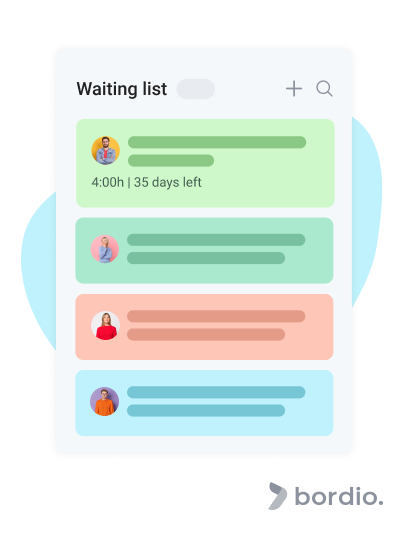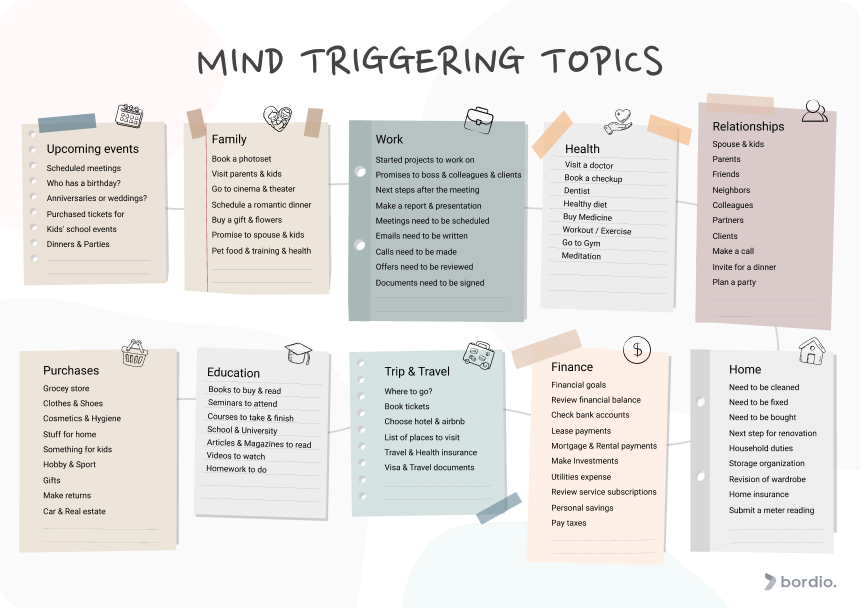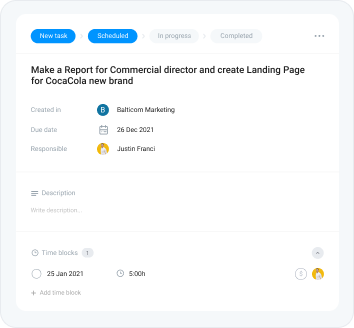When it comes to time management and being productive, a lot of theories, methodologies, tools, productivity books, and steps exist that we can take.
And no matter how many techniques we implement already or how well we are doing right now, it’s good to run a regular review of all the things we practice and stay open to new ideas.
The current realities are that most people have so many things to worry about that it’s hard to focus on anything. Despite the fact that we have various aids and modern online planners, it’s still not easy. And Bordio is on a mission to help as many people as possible create a system where they can decide what’s important and what’s not, complete all tasks, and have a clear headspace without the unproductive pulling by all the ideas, responsibilities, and commitments. If you have too many responsibilities, you need to be sure to delegate them. One tip on how to reduce the workload is to try contacting a digital marketing agencies for startups to find those who will do marketing duties well.
Today we will explore the concept of the mind sweep, see what it is, how it works, and what are the benefits. So, if you are interested in becoming the best version of yourself, then keep on reading.
What is a GTD mind sweep?
The mind sweep is a stress-free productivity practice where we identify and write down everything that has our attention, steals our focus and keeps clogging our minds and calendar planners, affecting all areas of our lives.
Once every thought and idea is on paper, our minds feel clear and not as stressed. That’s when we can start working on the thoughts one by one.
David Allen originally introduced the mind sweep in his bestselling book Getting Things Done (GTD). The GTD method has become one of the most popular and widespread productivity methods, with the fanbase still growing to this day. The mind sweep can and should be applied to enhance personal life and assist with professional development.
In his Getting Things Done book, David emphasizes the importance of exercising a complete brain dump and focusing on what’s truly important to reach the best results and be the most efficient. He recommends cleaning out the space you are living and working in, putting things in their places and getting rid of anything that no longer has a purpose. Once that step is over, we move on to the mind sweep, which is essentially a clean up of our minds. In general organize your life just like the organized to-do’s in the modern online schedule builder.
By the way, if you are looking for a bit of companionship or social accountability, you can check the guided mind sweep events that David Allen company organizes online.
Why is it important to do a GTD mind sweep?
All the little things and worries capture our attention, distract us from being focused and productive, and make us feel overwhelmed.
As the productivity consultant David Allen explains, the reason for all those open loops/issues/ideas floating in your head is that you don’t allocate enough attention to them. And as paradoxical as it sounds, when you don’t have closure with some tasks in your free day planner (meaning, you haven’t fully processed them, created a plan, and taken action), they are stuck in your head until you face them.
And the emotions that are attached to those things influence how often and how much we keep on remembering them.
How to do a GTD mind sweep?
The purpose of the mind sweep is to empty our short-term memory space and relieve us from constant stress and worry. And to do that, we need to process everything that we think about and spend mental energy on.
As the first stage, David Allen recommends finding a quiet place where nobody will distract you, getting a bunch of paper sheets and dumping all your thoughts and ideas on them. Once you have mastered the technique, you will be able to enter your thoughts directly into the project management tool. It is important to avoid writing all points on a single sheet and keep a separate piece of paper for each project, as it will be easier to work through them later.
Tip: If you’re a busy project manager, a parent to young kids, or can’t ignore notifications on your phone, wake up extra early on the day you plan to do mind sweep and start before everyone else wakes up.
This GTD methodology takes more than one step, and the next action is to capture all the top of mind stuff and write it down. Be careful about ideas that pop up that you’ve already written down somewhere. You may skip or write them down again, as there might be unfinished business with them.
Here are a few questions to get you started:
- What’s on your mind now?
- What do you have to do today that is not on the to-do yet?
- What stops you from focusing on the important stuff?
- Are there any problems that you need to pick up later that are on your mind at the moment?
- What are the top-7 things you are expected to be handling well at work?
- How would you be evaluated on your annual performance review?
- What usually comes up on your 1-on-1 meetings with manager?
- What are the things you’d like to do for fun? Concerts, shows, games?
- Any courses/classes you wanted to take?
New technological solutions for the GTD Mind Sweep exercise
The GTD method was first introduced a couple of decades ago when technology was nowhere near where it is today. So, in the book, many recommendations are connected with writing on blank pieces of paper, which we don’t have to do these days.
If you are looking for a technological solution to do a mind sweep on the digital device, you can try the Bordio online to-do list solution. You can utilize Bordio’s unique waiting list to dump all the inputs and work on them later. Bordio also has a handy free task tracker. The waiting list is a special area to the right from the calendar where you can put all unscheduled tasks and upcoming events, so it works perfectly for mind sweeping. And once you’re done with the first step of the process, you can re-visit the waiting list and continue working with all the tasks.
Tip: as you write things down, don’t worry too much about the phrasing. Think of something, write it down briefly, move on to the next thing. Focus on the end result: the complete brain dump. The feeling of accomplishment of a task will also be brought by crossing out the task record in your portable time planner calendar.
We prepared a cheat sheet with a list of mind triggering topics to help you completely clear mental space and not forget something important. We recommend doing a mind sweep regularly. That’s why we’ve added a downloadable PDF for you to use later. Keep it somewhere easily accessible, like your desktop.
As you continue the mind sweep exercise, think of the recent events. What happened yesterday or during the week? Are there any family social events that you committed to? Take a look at your diary and calendar, and walk around the space you’re in. Sometimes looking at everything surrounding us sparks an association, and we remember things that have completely slipped off our minds.
What should you do next?
After you’ve written all the open loops down, go through the list, check everything, organize and sort tasks.
Is it actionable? Yes or No? Yes – good, write down the next steps. Have non-actionable items? Okay, leave them as is.
For example, you wrote ‘wedding anniversary’. Why did you do that? Maybe it’s coming up in 3 weeks. Is it actionable? Yes, because you have a tradition to celebrate it with good food, wine and spending the day with just the two of you. What are the next steps? Book a restaurant, plan activities before or after, browse and practice breakfast recipes to surprise your partner, maybe brainstorm ideas for a present and then buy it. Then you can use the time management tool to enter the tasks.
Same thing here, Bordio’s task planners would be a perfect tool for this step. Every task and event that you’ve listed earlier can be edited with the next steps, a due date, and additional dependencies. You can easily convert tasks into projects for more convenience and efficiency.
Bonus tip: If you struggle to come up with the next actions and steps, ask yourself: What’s the desired outcome for me?
Once the next steps and action plans are outlined, you have a project at your hands. Congratulations! Your worries are finally written down, thought through, you know what to do, and you have peace of mind.
Next, put the project list in front of you (or view it in Bordio’s simple schedule maker), look at each one and ask yourself a series of questions:
- Does the task fall under the two-minute rule? If the answer is Yes – do it now.
- If the answer is No – can you delegate it to someone else? If you can’t delegate it – defer it.
- When would be the right time to work on it? Put it in the calendar.
Big work projects have implementation plans, and your personal or work tasks can emulate that, in order for you to reach the best results.
At the end of the process, you will experience what David Allen calls ‘mind like water’. It is a state of mind when nothing unproductive stresses you out, and your mental space is clear, clean, and structured. That’s when we become most focused, productive and happy.
Final thoughts on GTD mind sweep
Whenever you feel stuck or overwhelmed, go ahead and do the mind sweep exercise.
Although the David Allen company created the concept, there is no concrete way of doing it, as long as it works for you. And, similarly, any time is a good time for mind sweeps, so we recommend regularly going back to this GTD methodology. Just like knick-knacks seemingly accumulating at home on their own, the tasks, projects, issues and ideas accumulate in our minds, causing additional stress. And if there is one thing that we have enough of right now, it is stress. And we surely don’t need any more of it! So make your life easier with his system and the best electronic planner.
The habit of doing mind sweeping regularly might put your life in order and change it for the better if you let it. Dedicate twenty to thirty minutes to this activity every other week, or start writing down those thoughts when you have spare time. As you get used to it, you might go ahead and add this GTD system to your review in the weekly planner.
And remember: it’s okay if you finish the mind sweep and end up feeling both conflicted. Facing your reality can be intimidating, but it is a positively productive starting place. When our brains are not occupied with a million things, all the mental energy is freed for creative ideas and better things with high value and the most rewards.
The mind sweep makes your mind completely clear. And what else can we ask for in this crazy world?
We hope you enjoyed this blog post, and we encouraged you to give the mind sweep method a try. Stay tuned for more articles on GTD philosophy, and make sure you check out our latest posts for more productivity-related topics.






